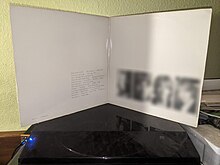
A gatefold cover or gatefold LP is a form of packaging for LP records that became popular in the mid-1960s. A gatefold cover, when folded, is the same size as a standard LP cover (i.e., a 12½-inch [32.7-centimetre] square). The larger gatefold cover provided a means of including artwork, liner notes, and/or song lyrics, which would otherwise not have fit on a standard record cover. It became famous as an extension of progressive rock, as the expansive, transient gatefolds by artists such as Roger Dean, H. R. Giger, or Hipgnosis became associated with concept albums.
Gatefold sleeves were also frequently used when an album contained more than one record, with Bob Dylan's 1966 double album, Blonde on Blonde being an early example of a multi-LP album to be released in a gatefold. Typically, double albums would feature one disc in each half of the cover, with larger albums either placing multiple LPs in one or both sleeves or using larger gatefolds. While some multi-LP releases (particularly those issued during the vinyl record's market dormancy from 1988 to 2007) would either package the discs in a simple sleeve or sandwich the records between two cards and shrink wrap, the prominence of gatefold for multi-LP albums led it to become the most common form of packaging for them.

Starting in the early 1950s, RCA used gatefold packaging for some of their deluxe 45 RPM single releases, such as Nat King Cole's eight-song "Unforgettable" EP, with two 45s, released in 1952. Gatefold packaging for LPs was popularized in the late 1950s by band leader and stereophonic studio recording pioneer Enoch Light so he could fit liner notes he had written describing the sounds in each song on the album sleeve. Disagreement exists as to the identity of the first gatefold LP packaging used with a traditional 33⅓ LP.[1]
The LP gatefold has also been adapted to package CDs without a jewel case.
- ^ "What was the first gatefold pop or rock LP?". Steve Hoffman Music Forums. 2003. Retrieved 28 April 2017.